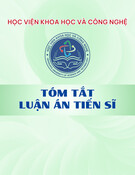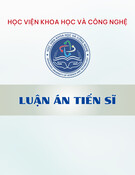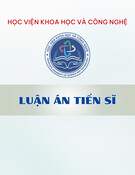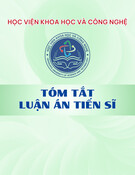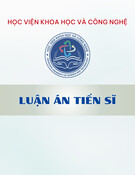1
INTTRODUCTION
1. Rationale of the study:
Currently, along with the development of society, people lives are
gradually improved and consume demand is increasing, leading to an increasing
amount of waste, especially domestic waste (DW). The average annual increase
is approximately 12%. The regular increase in domestic waste causes an
increasing amount of leachate. Leachate is generated from both landfills and
transfer stations containing high polluted levels with Chemical Oxygen
Demand (COD) up to 70000 mg/l, Dissolved Solids (DS) up to 50000 mg/l,
Total Suspended Solids (TSS) to 2000 mg/l and nitrogen content up to 3000
mg/l,… Leachate with badly stink affects to surrounding areas and contaminate
the groundwater as well as pollute surface water sources. Therefore,
environmental pollution by leachate has always been a serious problem which
get special attention in environmental protection.
Although, according to regulations, each landfill must have a leachate
treatment system, most of the current leachate treatment techniques in our
country still reveals many weaknesses neither the quality of treated water often
does not meet the effluent standards, especially the COD and nitrogen
parameters (VN standards 25: 2009/MONRE column B), nor difficult operation
and expensive cost. The reason comes from the leachate characteristics with the
complex composition and the continuous change by the landfill operating time.
The selection of inappropriate treatment technologies has resulted in non-
responding to discharge standards, while the leachate in landfills increases
continuously. Hence, it is necessary to find some appropriate technologies
which are able to handle all the daily leachate, improve current leachate
treatment systems and equip for the new landfills.
The option of combining electro-coagulation (EC) with biological filtration
(BF) is one of the promising solutions to increase the effectiveness of leachate
treatment. Unlike chemical coagulation, a large amount of coagulants must be
used, thus consuming a lot of chemicals as well as creating a great amount of
generated sludge, the EC process has the ability to remove effectively heavy
metals, phosphorus compounds, phenol compounds, hydrocarbons and several
pathogenic microorganisms, which are difficult to decompose by biological
methods. In addition, this process is also easy to automate and minimize the use
of chemicals thus reducing the amount of generated sludge. Meanwhile, the BF
process has the high treatment performance of suspended compounds (TSS),
total nitrogen (TN) and BOD5. In particular, the BF process on inexpensive
organic substrates such as peat, wood bark, and plastic have a higher treatment
efficiency than conventional BF processes. The reason is that the porous
organic substrates have a large specific surface area which is possible to absorb
a large amount of microorganisms, together with other physicochemical
processes, leading to very strong nitrate reduction. Combining two above






